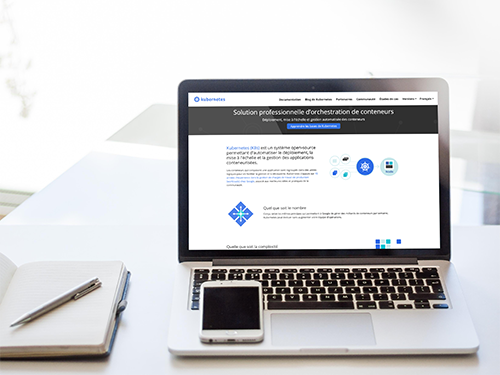Kubernetes, containerize your infrastructure
An open-source project initiated by Google in 2015, Kubernetes (K8s) is a technology that simplifies the management of containers in your infrastructure. Takumi Cloud supports your teams in migrating your Kubernetes infrastructure and automating the deployment pipeline.
Migrate my infrastructureWhat is Kubernetes?
Today, applications are designed using containers like Docker. These containers allow you to segment your application into microservices and have different configurations for each. These configurations enable, for example, deploying these microservices independently to accelerate certain feature deliveries.

Kubernetes (also known as K8s) is a container orchestrator launched by Google in 2015 and later donated to the Cloud Native Computing Foundation (CNCF). Kubernetes is a technology that facilitates container management within your infrastructure and ensures application stability. In other words, with K8s, you can automate deployments, management, networking, scaling, and availability of containerized applications.
According to us, applying a DevOps methodology with Kubernetes is easier. This technology brings your infrastructure speed, flexibility, scalability, and stability. Furthermore, containers and K8s significantly bridge the gap between developers' local environment and production environment (ISO environments), resulting in fewer bugs in production.
The benefits of Kubernetes
To meet demand and optimize resource usage, applications must be scalable. Kubernetes automates scalability to eliminate resource waste.
Scaling is automatic and pre-configured: if a percentage of CPU, RAM, or any other metric relevant to your application is exceeded, new container instances and servers are deployed. This redistributes traffic and prevents application saturation. As traffic and CPU or node consumption decrease, the number of servers and container instances also decreases.
Thanks to templating tools related to K8s like Helm, resource configuration files are standardized. This ensures a consistent quality standard across all applications deployed in a Kubernetes cluster.
Versioning of K8s resource files also allows for adopting a code review and automated deployment process, significantly reducing the introduction of bugs.
Why choose Takumi Cloud
-
High-level Kubernetes expertise
-
Tailored solution for any type of legacy
-
Proven DevOps and Lean methodology
-
Kubernetes training for your teams
Our partners
Google Cloud, Amazon AWS, Microsoft Azure, and Kubernetes trust us to implement their technologies in for our clients.
